USS Navasota (AO-106)
Navasota's new midbody being launched at the Kawasaki Dockyard Co., Kobe, Japan, on 11 August 1963. The midbody was then towed to the Puget Sound Bridge & Dry Dock Co., Seattle, Wash., where it was used in the tanker's "Jumbo" conversion. The same process was used for Waccamaw.
Photo No. None
Source: U.S. Naval History and Heritage Command
|
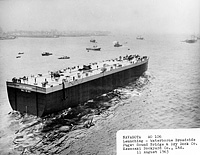 |
USS Mispillion (AO-105)
Mispillion's new midbody, built at the conversion yard at Lorain, Ohio, moored alongside the original ship. The new cargo deck is in place aft of the transverse beams that were to receive the midship house but not forward of them. This and the following five images relate to the three conversions at Lorain, including Pawcatuck and Passumpsic. Note that Mispillion lacked the reinforced fueling goalpost mast aft that her sisters got.
Photo No. BUSHIPS 170816, NAID 7573915
Source: U.S. National Archives (RG-19-NN, negatives)
|
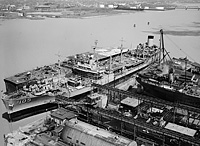 |
USS Pawcatuck (AO-108)
Pawcatuck's midship house on 12 October 1965 after being transferred onto the new midbody.
Photo No. BUSHIPS 171889, NAID 7574076
Source: U.S. National Archives (RG-19-NN, negatives)
|
 |
USS Pawcatuck (AO-108)
Pawcatuck's stern being joined to the new midbody on 12 October 1965. Note the retention of the old after refueling goalpost mast.
Photo No. BUSHIPS 171891, NAID 7574078
Source: U.S. National Archives (RG-19-NN, negatives)
|
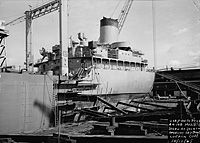 |
USS Passumpsic (AO-107)
Passumpsic going both ways during jumboization. The stern is probably attached to the new midbody, on which the midship house is visible. The bow is probably still attached to the original midbody. Note that the 3" guns are still on board at both ends.
Photo No. NH 65375
Source: U.S. Naval History and Heritage Command
|
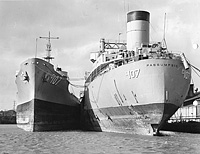 |
USS Pawcatuck (AO-108)
Pawcatuck's bow on 3 November 1965 after being joined onto the new midbody.
Photo No. BUSHIPS 171887, NAID 7574074
Source: U.S. National Archives (RG-19-NN, negatives)
|
 |
USS Pawcatuck (AO-108)
Pawcatuck fitting out on 14 November 1966.
Photo No. BUSHIPS 175185, NAID 7574113
Source: U.S. National Archives (RG-19-NN, negatives)
|
 |
USS Waccamaw (AO-109)
Running post-conversion trials at about 16 knots on 16 February 1965.
Photo No. BUSHIPS 170479, NAID 7574123
Source: U.S. National Archives (RG-19-NN, negatives)
|
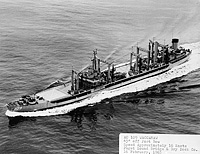 |
USS Pawcatuck (AO-108)
Underway circa the late 1960s.
Photo No. Unknown
Source: U.S. Naval History and Heritage Command (UA-164)
|
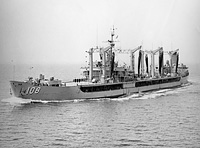 |
USS Mispillion (AO-105)
Underway circa the late 1960s.
Photo No. Unknown
Source: U.S. Naval History and Heritage Command (UA-164)
|
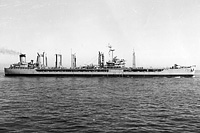 |
USS Pawcatuck (AO-108)
Underway in the Mediterranean circa the early 1970s. This photograph was received in Washington D.C. for filing in November 1973.
Photo No. KN-21025
Source: U.S. Naval History and Heritage Command
|
 |
USNS Passumpsic (T-AO-107)
An undated starboard quarter view. The large, tall object just foward of the after superstructure is the exhaust stack for the three diesel engines that had been installed there to power the ship's new cargo winches. As a MSC ship she has no armament or hull numbers on her bow or stern.
Photo No. None
Source: U.S. Naval History and Heritage Command (MSC)
|
 |
USNS Pawcatuck (AO-108)
Replenishing USS Doyle (FFG 39) in the Atlantic at the equator on 9 October 1990. Note the reapparance of the large bow hull number on the MSC ship.
Photo No. DN-SC-91-01685
Source: U.S. Naval History and Heritage Command
|
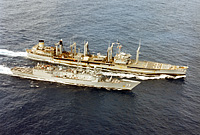 |
USNS Navasota (T-AO-106)
Underway in February 1991 during exercises off the coast of southern California. The single fueling station forward of the bridge was removed from this class at around this time to clear more room on the bow for helicopter operations.
Photo No. DN-SC-92-08694
Source: U.S. Naval History and Heritage Command
|
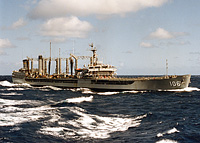 |













